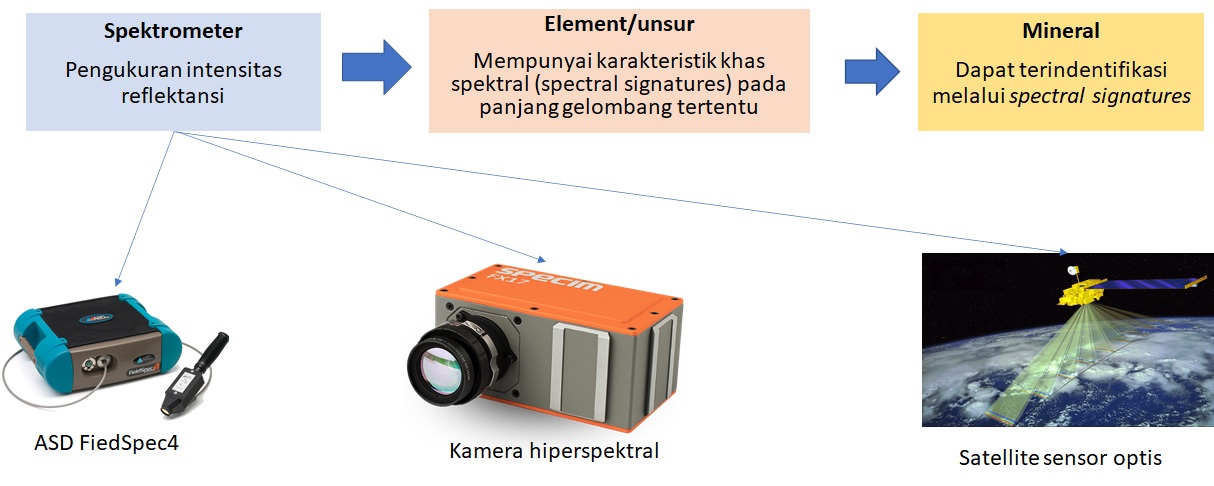Basic Research on Reflectance Spectroscopy for Exploration of Minerals Carrying Rare Earth and Radioactive Metals in Indonesia
Reflectance spectroscopy and hyperspectral imaging are non-destructive methods included in remote sensing which are quite powerful in finding mineralogical information in inaccessible areas, where information would be difficult to determine by other exploration techniques. This technique has several advantages, such as being sensitive to crystalline and amorphous objects and can be used at very close distances (laboratories) or very long distances (satellites). Variations in material composition often cause changes in the position and shape of the absorption spectrum bands. This principle is the basis for using remote sensing methods, especially for optical sensors, to track materials (including minerals and rocks) on earth because their reflectance spectral characteristics are very specific (Figure 1).

Gambar 1. Kaitan spektroskopi reflektansi dalam identifikasi mineral.
On the other hand, currently Indonesia is developing advanced materials such as rare earth elements (REE) and developing nuclear technology for energy sources. However, information on the potential for REE-carrying and radioactive minerals is still very limited. In order to support direct exploration of REE and radioactive minerals in Indonesia, research and preparation of a hyperspectral database that can be utilized in prospecting/preliminary exploration activities in the form of remote sensing is very necessary. Plus, in preparation for hyperspectral image data which is increasingly developing with various vehicles that are ready to be launched in the next few years. Until now there is relatively little information and publications regarding hyperspectral imaging of REE-bearing and radioactive minerals, especially in Indonesia.
Through the 2019–2020 Basic Higher Education Basic Research (PDUPT) scheme funded by the Ministry of Research and Technology and the 2020 KK ITB Research Program funded by the Bandung Institute of Technology, research was carried out on reflectance spectroscopy for the exploration of REE and radioactivity-bearing minerals, chaired by Ir. Arie Naftali Hawu Hede, Ph.D. and research member Dr.Eng. Ir. Syafrizal and Ir. M. Nur Heriawan, Ph.D and assisted by two Master of Mining Engineering students in the Special Field of Earth Resources Exploration, Muhammad Anugrah Firdaus and Yogi La Ode Prianata. Through the 2019–2020 PDUPT scheme, the research is entitled Reflectance Spectroscopy and Hyperspectral Imaging for Exploration Mapping of Minerals Carrying Rare Earth and Radioactive Elements, where this research aims to study the typical characteristics of hyperspectral imaging for mineral and rock samples carrying REE and radioactive elements in Indonesia. The resulting database can also support further research needs including integration with other exploration methods. Meanwhile, in the 2020 ITB KK Research Program scheme, the research entitled Development of a Quantification Method Using Visible-Shortwave Infrared Spectroscopy Data for Determining Chemical Content and Mineral Mapping in Remaining Areas from Tin Mining to Support Mining Conservation, aims to develop a method for quantifying chemical elements and identifying mineral content related to tin by-product minerals from tin mining waste sites using reflectance spectroscopy. This research also collaborates with PT Timah (Persero) and the Nuclear Minerals Technology Center (PTBGN-BATAN) which has provided permission for the research location and samples for analysis.
The output of this research has resulted in several publications in journals, national and international proceedings, some of which have even received awards (Figure 2 and Figure 3).
- Hede, A. N. H., Firdaus, M. A., Prianata, Y. L. O., Heriawan, M. N., Syafrizal., Syaeful, H., Lubis, I. A. 2019. Spektroskopi Reflektansi Sampel Tanah dan Batuan yang Mengandung Mineral Pembawa Unsur Tanah Jarang dan Radioaktif. Eksplorium, Vol. 40, No. 2, 89-98. http://dx.doi.org/10.17146/eksplorium.2019.40.2.5644
- Hede, A. N. H., Prianata, Y. L. O., Syafrizal., Heriawan, M. N., Syaeful, H. 2019. Visible-shortwave infrared reflectance spectroscopy features of samples from Mamuju, Indonesia containing radioactive minerals. Internasional Symposium on Earth Science and Technology 2019.
- Hede, A. N. H., Firdaus, M. A., Heriawan, M. N., Syafrizal., Lubis, I. A., 2019, Identification of rare earth element–bearing minerals using reflectance spectroscopy on sample from alluvial tin mines in South Bangka, Indonesia. 2nd International Congress on Earth Sciences in South East Asia.
- Hede, A. N. H., Prianata, Y. L. O., Syafrizal., Heriawan, M. N., Syaeful, H., 2020. The applicability of reflectance spectral features and remote detection for radioactive mineral exploration in Mamuju, West Sulawesi, Indonesia. The 3rd Conference of the Arabian Journal of Geosciences.
- Firdaus, M. A., Hede, A. N. H., Syafrizal, and Heriawan, M. N. 2020. Exploring Spectral Reflectance to Identify Rare Earth Element-Bearing Minerals Associated with Alluvial Tin Deposits. International Symposium on Earth Science and Technology 2020.
- Hede, A. N. H., Syafrizal, and Heriawan, M. N., Mohamad N. 2020. Pemanfaatan spektroskopi reflektansi dalam pengindraan jauh sensor optis untuk eksplorasi mineral. Prosiding TPT XXIX PERHAPI 2020.

Figure 2. Best paper certificate on Track 6. Geo-informatics and Remote Sensing at the 3rd Conference of the Arabian Journal of Geoscience organized by The Arabian Journal of Geoscience – Springer.

Figure 3. Best paper certificate at the 2020 International Symposium on Earth Science and Technology organized by the Cooperative International Network for Earth Science and Technology.

